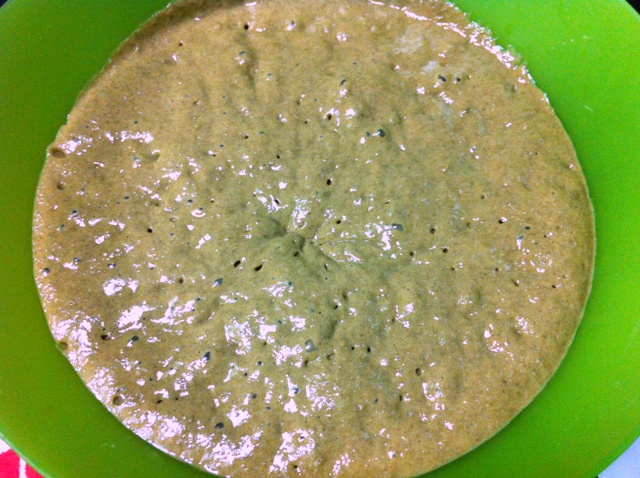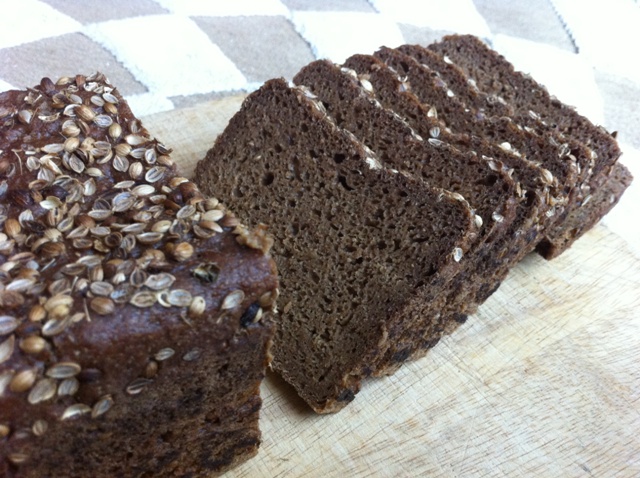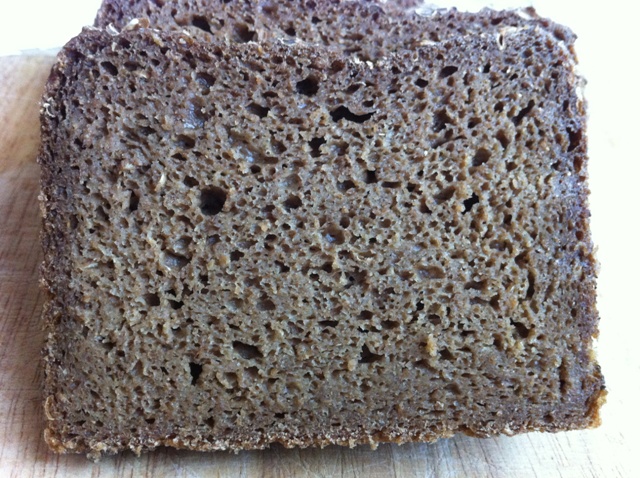
The last of 2013 - Andy’s Borodinsky – Take #1

Last week, I went to a health food store in Dubai to pick up some Rye berries, and black strap molasses. To my dismay, I could not find any malt syrup in the store, and left to a shopping mall for lunch. Located next to the food court was yet another health store that quickly caught my sight. I went in, and asked for barley malt syrup, and the salesperson said that they do not sell it anymore. I was just on my way out when I heard him calling upon me and saying: Wait, I have some barley extract! It was slightly expensive for what it was, a syrup, but I gladly bought it anyway.

Having had two ingredients that would likely make my planned borodinsky as close to authentic as possible, I decided to refresh my dormant rye starter. Andy’s recipe : here, was followed to the letter, with no deviations at all, except the fact that I replaced Rye malt with Barley extract syrup as I had no rye malt. I milled the rye berries, and mixed the fresh flour with the non organic rye flour I had in store. Everything came together as expected, and I was quite content with the process. The Sponge was mixed and immediately refrigerated for 6 hours and when I returned home, I removed it from the fridge to warm up.



I mixed the final dough, and left it to ferment for 1 hour. It was then divided into 1.3 Kg for the Pullman pan (with lid on), and 5.5 Kg for a smaller Pan. Final fermentation was a scant less than an hour, and the pans went into a 260 C oven for 10 minutes, and at 100C for 4 hours. The aroma of coriander and the slowly caramelizing rye and molasses were very sweet and satisfying. The tiny loaf in the pan did not grow much in the oven, but I was in anticipation of a good height to the Pullman loaf. After 2 hours I had a peek to register the temperature of the crumb, and slid off the Pullman lid to see a sunken top… Ugh! Ok, what have I done wrong?
It didn’t take me much time to find the culprit behind my sunken loaf. Hydration! Andrew whitely talked about it in his book: Bread matters but I underestimated the importance of it in rye breads, especially those with high % of prefermented flour. I had added more boiling water to the soaker while making up for the loss in evaporation. I have also failed to notice that Andy’s recipe uses thirsty rye flour, while mine is not as absorbent.
Unfortunately, The Pullman pan’s blue steel coating was corroded due to the molasses, and the long moist baking. You may notice the iron oxide patches on the bottom and the sides of the loaf. If I ever bake such breads in this pan again, I’ll have to line it with parchment.


When cooled, I wrapped the loaves in linen, and waited 24 hours to cut the small loaf, and a 36 hours to cut the Pullman one. The crumb was soft and very moist, but not gummy. The crust was neither hard nor soft. The bread was super delicious, with hints of molasses/ malt. Coriander’s flavor, of course was prevalent. Perhaps I added too much crushed coriander as garnish.
-Khalid


Comments
What a great looking bake Khalid. I'm sure Andy will chime in but I would say it looks perfect to me.
Happy New Year and look forward to seeing your next bake.
Regards,
Ian
Thanks alot, Ian!
Happy New year to you too.
I don't worry about sunken tops because the one baking thing Lucy lacks is a Pullman but. it could be a simple thing like not having quite enough dough in the pan or letting it rise enough in the final proof? The good rye bakers on TFL will know for sure. One thing we know is that it doesn't effect the taste one iota. I say well done and this is one fine looking loaf of bread and the coriander had to make the house smell terrific.
Get some red rye malt, some scalded rye berries in there and Nirvana will be yours!
Happy baking in the new Year Khalid
Thanks, DA!
Um, i stand by my reasoning on this one DA :) i've freakin done everything by the book here! But you're right, the flavor is totally intact.
Thanks for the lind words, and happy new year to you too!
Hi Khalid, Beautiful Borodinsky, So glad you were able to find the ingredients to make it. Looks absolutely delicious, as you say it is. I leave off the coriander topping, as I just can't tolerate that much coriander, but it sure makes it look pretty. -Varda
Thanks Varda! Your numerous posts on borodinsky were really helpful and inspiring.
Are you still participating in farmer's markets?
All the best to you.
I've had a break from farmer's markets for a couple months but start up again in a week, indoors, which is a good thing as it was 0F this morning. The markets I'll be doing this winter will be a lot larger than what I did last summer. Lucky that I had some time to learn how to use my oven, as I'm going to need the capacity. I'm also starting to approach restaurants in the area. Some interest but nothing firm as yet.
Great news, Varda! Keep us posted.
That's awesome Varda...I'm sure you will be very successful and like Khalid said keep us posted.
Hi Khalid,
So glad you were able to get some malt syrup. Persistence pays off again!
Your loaf sounds like you got the baking times and temps down just right. When I bake this loaf the coriander is strong too so I have cut back on it a bit to let other flavors blossom too.
Hope your new year is bright and full of opportunity for you.
Janet
Thanks , Janet!
Now, for a reliable bulk source of malt. As to coriander, you are right, moderation is key.
Thanks for the warm words, Janet! Always much appreciated.
Noticed you and Khalid thought there too much coriander with Andy's formula. He actually uses double the GOST standard of 0.5%, so you're with the masses.
Hi Khalid,
From the crumb, it looks like your bread was perfectly fermented.
And such a tantalizing description!: "The aroma of coriander and the slowly caramelizing rye and molasses were very sweet and satisfying." That's why I love this bread so much, for the aroma during baking, and the taste...
I'm so sorry your pan discolored. I had the same thing happen when making the Horst Bandel Pumpernickel - a wet dough and long contact time with the pan.
What a beautiful bread to finish 2013 with - wishing you many more beautiful bakes for 2014!
:^) breadsong
Thanks, Breadsong :-)
It was Andy's recipe, his unwavering enthusiasm and the wonderful posts on the bread by TFL members, that set my off.
So what did you do to salvage your pullman pan? I greased mine with oil after rubbing off the excess rust, and inserted it into the 100c oven for 3-4 hours. Next morning, there was a varnish like coating that seemed impervious to further rust. I didn't intend for it to be this way, but it may prove useful.
Thanks alot for the nice wishes! You too.
Hi Khalid,
It sounds like you did the best thing for your pan, seasoning it.
My pan was aluminum, and it's discolored - it may have oxidized?
I wasn't going to do anything other than oil and flour it prior to next use - I may decide to line it with parchment,
I hope you get lots more use out of your pan, now that you've repaired the finish!
:^) breadsong
I've made several high percentage ryes. The ones made in pans have caused me much more frustration than the hearth loaves. I think they are more demanding and, like other breads, you need to make them enough times to learn their unique needs.
We're lucky to have some more experienced rye bakers around to accelerate our learning.
Happy New Year to you, Khalid!
David
Yes, That is so true David. A pan will help keep your dough upright, but it can also be the cause of its collapse.
Thanks so much David, and a happy new year to you too!
Before Christmas, I said to myself that in 2014 I will start baking more with rye. The truth is I have never baked any loaf of Borodinsky or Danish rye or Pumpernickel before although I do enjoy eating those breads enormously.
Thank you for posting your bake. Your loaf looks so delish. When I read your post yesterday here, I was getting an itch to bake but we are away from home at the moment for summer holidays. I think I will start with Borodinsky as I already had all the ingredients in my pantry.
Happy New Year!
Cheers,
Annie
Keep up the pledge, Annie! we want to see your first borodinsky soon.
Happy new year! and may you enjoy your vacation, and have a safe trip back home.
All the best.
Hi Khalid,
I am really glad you managed to find some of the ingredients you were looking for to make this bread. It cannot be easy seeking out malt in Dubai since its primary use is in the manufacture of beer and whisky.
Good job!
A couple of pointers for you. Yes do watch the hydration, although I have found the temperature at which you make the scald to be of greatest significance. The hotter the mix, the greater the degree of gelatinisation. Given Andrew Whitley aims for 100% hydration in his Russian Rye breads these days, I would be loathe to advise you to follow this; baking out such a high hydration is very difficult indeed.
But I would look at something else. You wrote that you held the sponge in the chiller for 6 hours. I don't think this is best practice. The idea of the sponge is to kickstart fermentation since you are using such a high proportion of sour in the formula. I ferment for 4 hours maximum, and aim to hold the sponge just over 30*C if possible. Retarding rye paste at any point seems pointless to me.
I have added more notes below if they are of any help:
Wishing you continued baking success for 2014
Andy
Hi, Andy! And many thanks for the guidelines.
As to retarding the sponge, i did it out of convenience. I had to leave for work in the morning and i couldn't let the sponge ferment for 8 hours at room temperature. I did not notice any adverse effect due to retardation, as i let it warm up to room temp. for 2 hours prior to being mixed.
I also noticed that you build your rye sour in two feeds. What benefits do you reap from doing so?
Best wishes to you and Alison!
Hi Khalid,
It depends....but I assume I will be using a small quantity of stock rye sour from my fridge...probably something like 40g. So it needs a good feed, of course. However, if I am in daily production mode, whilst one feed is quite sufficient, I tend to use a small feed to kickstart the ferment, then a bigger feed with a long ferment to make it sour.
Yes, I appreciate this procedure does not sit well with other work schedules. You'll just have to become a baker!
Best wishes
Andy
Hello Khalid and Andy,
I hope you don't mind me jumping in and sharing my experience here.
A few months ago I was building a rye levain for a Borodinsky, and wasn't watching it closely enough.
The levain peaked and was over-ripe by the time I checked it, so I decided to 'borrow' some of the rye flour and water from the final mix and do a 2nd build.
I think the 2-stage levain build intensified the flavor - I was very pleased with how the bread tasted - I'm going to work this in as a regular part of the process.
:^) breadsong
Hi breadsong,
2 essentials about rye; firstly the sour is vital to the process to protect the delicate pentosans, and, secondly rye flour [particularly a certain organic wholegrain rye flour you and I have used] is emminently fermentable.
But it still needs a good supply of food, just like any leavening culture. Have you tried the Auerman process yet?
Happy New Year to you!
Andy
Hi Andy,
Thank you! - for the flour :^), the wealth of information you provide in your comments and formulas (looking forward to exploring those links above), and for the New Year wishes!
I have not tried the Auerman process yet.
But the best-tasting breads (to my taste) I have ever made, have had multiple-stage levain builds at varying hydrations.
I will give the Auerman process a try and let you know how it turns out.
My very best to you for 2014!
:^) breadsong